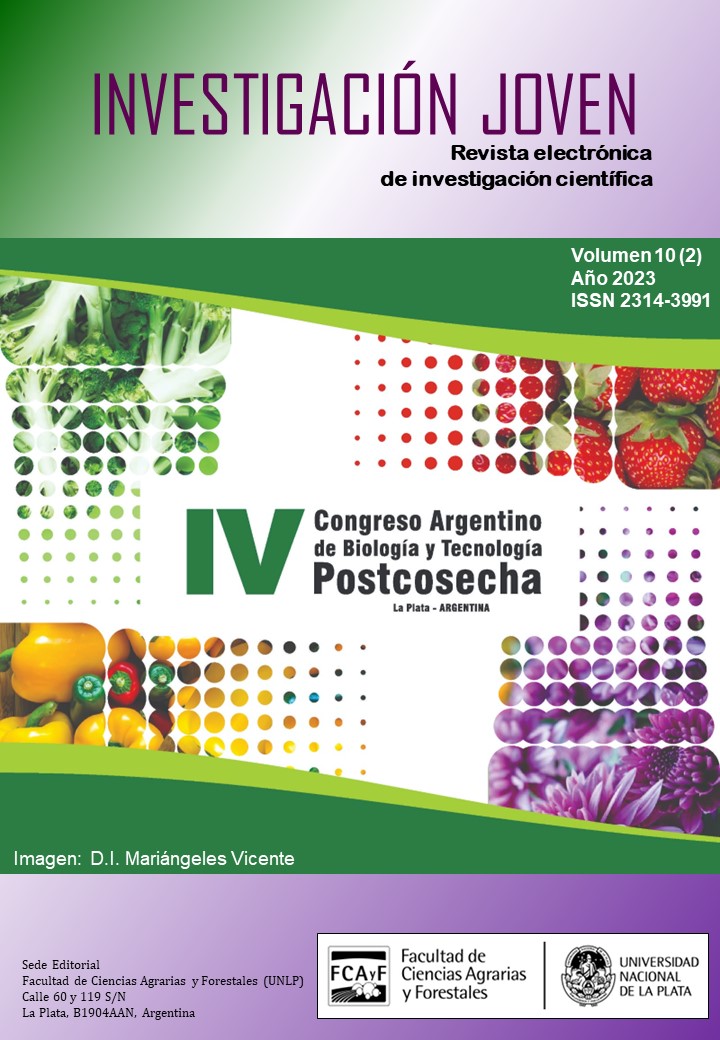Curative effect of pyrimethanil and fludioxonil in the control of Penicillium expansum (L.) on apple (Malus domestica) cv. Granny smith using recirculated spray broth on packing line
Keywords:
postharvest treatments, application efficiency, recirculated brothsAbstract
Penicillium expansum (L.) is one of the main pathogens causing great losses during fresh fruit conservation. Among the fungicides used for pathogen control during postharvest of apples and pears, pyrimethanil of the anilinopyrimidine family (FRAC 9) and fludioxonil of the phenylpyrroles family (FRAC 12) stand out. The spraying systems that allow the application of sanitary treatments on the process line present an inherent inefficiency in their design that modifies the effectiveness of the products used. Most of them are of the hydraulic type and must guarantee the homogeneity of the spray liquid and its spraying during the whole working day. One of the improvements that have been incorporated in these systems is the possibility of reusing the broth, which implies two advantages: one clearly economic by reducing the concentration of active ingredient per ton of fruit, and the other environmental, since the disposal of broth with residues is reduced. In the present study, different types of recirculated broths were used before being sprayed on fruits inoculated with Penicillium expansum (L.). For this purpose, pyrimitanil and fludioxonil fungicides were recirculated for 12 hours in a mixture with concentrations of sodium hypochlorite (20 mg/hl) plus peracetic acid (250 ml/hl) or chlorine dioxide (100 ml/hl) plus peracetic acid (250 ml/hl) and 2.5 gr/hl of organic matter. A total of 540 fruits were selected and immersed in a 3.5 ml/hl sodium hypochlorite solution for 30 seconds. Once dried on the honeycombed trays, a wound was made in the equatorial zone with an awl (2 × 3 mm). Then they were inoculated with 20 μl of a solution of Penicillium expansum (L.) with a concentration of the order of 1×103 conidia/ml. The fruits were left for 12 hours at room temperature (20 °C), to allow the spores to start the infection process. They were then treated by immersion for 30 seconds. A completely randomized design with 9 treatments and 3 replicates of 20 fruits each was used. The response variable was the count of the number of fruits with symptoms, estimating the percentage of incidence and the percentage of relative efficacy with Abbot's correction. The data were analyzed by nonparametric analysis of variance and the comparison of means was performed with the Kruskal-Wallis statistic using Infostat software version 2020. The percentages of relative efficacy were between 96% and 100%, which led to the conclusion that the presence of high concentrations of sodium hypochlorite, chlorine dioxide and organic matter in the water that makes up the broth does not affect the activity of the fungicides evaluated, which would imply that they are suitable for hydraulic spraying systems with a broth recirculation system. Phytotoxicity symptoms were observed in the broths with chlorine dioxide in all replicates for both fungicides.
Downloads
References
Di Masi, S.; Dobra, A. 1999. Enfermedades de poscosecha. Fruticultura Moderna. 121-125.
Dobra, A.; Rossini, M. 1993. Patógenos de postcosecha: Aspectos epidemiológicos, resistencia a fungicidas y su control. Curso internacional de sanidad en frutales de pepita / INTA EEA Alto Valle. Cap. 11:22.
R. Murray, A.P. Candan, D. Vazquez. Manual de poscosecha de frutas: Manejo integrado de patógenos. INTA Ediciones.2019.
Fungicide Resistance Action Committee (FRAC). https://www.frac.info/fungicide-resistance-management/by-frac-mode-of-action-group. Consultado 05 de Mayo 2023.
J.E. Adaskaveg y H. Förster. “New developments in postharvest fungicide registrations for edible horticultural crops and use strategies in the United States”. Postharvest pathology. 2010. pp 107-117.
J.E. Adaskaveg, H. Förster y D. Chen. “Progress on chemical management of postharvest diseases of subtropical and tropical fruits”. Postharvest Pathology: Next Generation Solutions to Reducing Losses and Enhancing Safety. 2021. pp 141-152.
Colodner, A. 2011. Optimización de las técnicas de aplicación de productos fitosanitarios en la línea de empaque de manzanas (Malus domestica, Borkh). Tesis de Maestría, Universidad de Bologna.
Colodner, A.; Candan, A.P. 2011. Control de podredumbres poscosecha en cerezas. Revista Fruticultura & Diversificación Nº 66, 40-45.
Colodner, A.; Di Masi, S. 2010. Determinación de la efectividad de Penbotec TM 40 SC (pyrimethanil) frente a Penicillium expansum y Botrytis cinerea, en tratamientos de poscosecha de fruta de pepita. Informe técnico INTA Alto Valle. 100 pp.
A. Colodner y P. Plaza. “Efectividad de control de enfermedades mediante un sistema de ducha de bines”. Revista Iberoamericana de Tecnología Postcosecha. 2012.
L. Pisano, M. Gallardo, C. Minué y N. Bachur. “Evaluación de la eficiencia de pirimetanil aplicado con un sistema de pulverización hidráulico sobre la línea de proceso con recirculado de caldo”. Eje temático VI: Biotecnología. Pág. 62. VI Jornadas de divulgación investigación y extensión “Investigar y enseñar para la agroindustria”. 2023.
J.J. Costa, A.E. Margheritis y O.J. Marisco. “Introducción a la Terapéutica Vegetal”. Argentina, Hemisferio Sur.1979
O. Bastidas. “Conteo celular con hematocitómetro: uso elemental del hematocitómetro”. https://www.scribd.com/document/105937668/Conteo-Camara-Neubauer Consultado 05 de mayo de 2023.
J.A. Di Rienzo, F. Casanoves, M.G. Balzarini, L. Gonzalez, M. Tablada y C.W. Robledo. “Software INFOSTAT versión 2020”. Centro de Transferencia InfoStat, FCA, Universidad Nacional de Córdoba, Argentina. http://www.infostat.com.ar
L.S. King. “Dr. Koch’s Postulates”. Journal of the History of Medicine and Allied Sciences, vol.7, no.4, pp.350–361. JSTOR, http://www.jstor.org/stable/24620063. Consultado 05 de Mayo 2023.
Downloads
Published
How to Cite
Issue
Section
License
Copyright (c) 2023 Leandro Pisano, Gladys Prieto, María Gallardo, Carlos Minué, Nicolás Bachur

This work is licensed under a Creative Commons Attribution-NonCommercial-ShareAlike 4.0 International License.
















